We arrived in Arughat at sunset. Mosquitos buzzed and the cold beer was welcome. It had taken us a long day of hard travel along bone-jarring roads, which featured potholes large enough to swallow tractors, to get here. We arrived, found a bed and crashed.
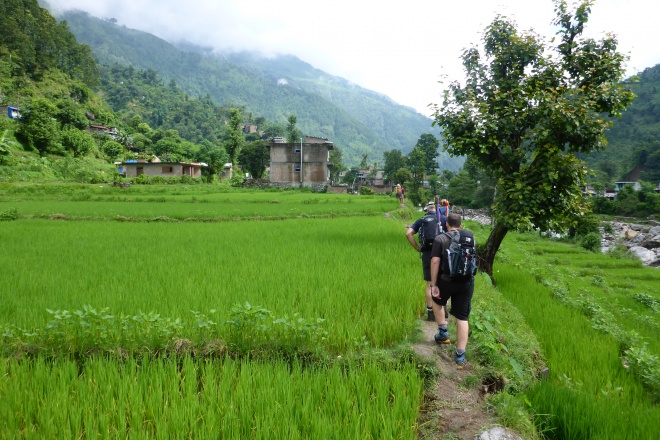
The next morning, five minutes after leaving the town heading into The Gorge, I took off my shirt and wrung it as dry as I could. A stream of sweat poured from it. The mountain we had come here to climb, minus 30 temperatures and epic alpine battles seemed kind of abstract, as we travelled through steaming tropical jungle and rice paddies. We had entered a less familiar world, where large spiders crawled through gaps in our dormitory wall and where for the first time in years I thought it necessary to drink real water during a day’s trekking. Lots of water and the occasional beer. I tried to recall what I had read about the mountain but the humidity and heat made this process difficult. All I knew about the first ascent team was that they had also come this way, joined this ancient trade route to the Tibetan border and after a long week trekking had reached the village of Samagoan. And that around a dozen of them had been whacked by an avalanche.
The trek to Manaslu base camp involves one of the lowest starting points for any 8,000 meter mountain, 560 meters, but I think it is probably unique in featuring a massive gorge as its main obstacle to reaching the base camp. You might get the rare glimpse of a distant snowy peak but mostly the views are dominated by the walls of the gorge. It narrows here, squeezing the river into a boiling mass and widens there onto wide fluvial plains supporting rice paddies and small communities but it is always prevalent; towering over all life within its flanks. Hundreds of waterfalls plunge over its edges and its enclosed forests harbour beasts that are only rarely glimpsed. Arthur was lucky enough to spot two frolicking Yellow Martens and we all spotted many monkeys and the occasional snake. The people that live in the gorge are totally self-sufficient. Arthur a carpenter by trade was amazed at how not one single plank beam or board is cut using power tools. Every house is made by hand; even the bricks are chipped out of a rock outcrop and carried to the building site by Sherpani girls. Everything that enters the gorge is carried on donkey or human backs, from nails to pot noodles. There are now the occasional tea houses cropping up but generally these are nothing more than an extension of someone’s house. It was great after a hard day’s slog to sit in front of a fireplace, drink a beer and watch the bustle of the kitchen and gossip with the family that lives there. Everywhere you stop to eat or sleep you are made to feel welcome, until recently very few trekkers entered the gorge and the feeling that you are just another passing bod as experienced on the popular Nepali treks where payphones and satellite dishes pop up frequently is rare. Here those “essentials” have not yet entered the mix and it is humbling to meet people who have it so tough yet welcome you as a friend into their houses and kitchens.
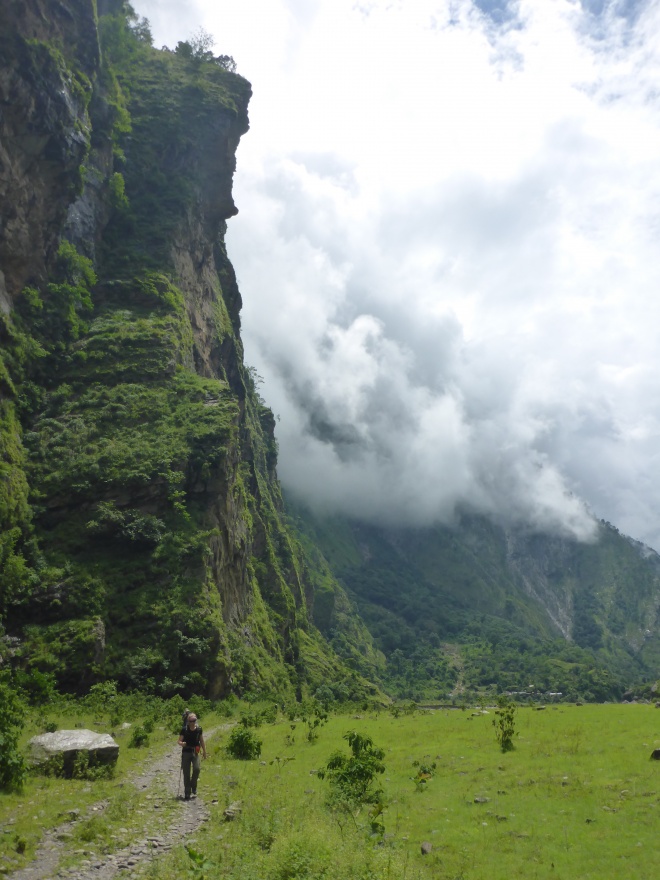
Eventually, you stumble out of the gorge and into the village of Samagoan. This place is a hive of activity and a bizarre mix of middle ages and modern progress. Wherever you look there are people working wood, shaping stone and lugging stuff from A to B. It’s like a life version of Fred Flintstone’s quarry. The aim of the building frenzy is to expand the place and to build enough lodges and tea houses to accommodate all the inhabitants of greater London or so it would seem.
We hadn’t seen a single trekker on the way in but all that changed when we got to Samagoan. Here we met not only trekkers from half a dozen different nations but various climbing teams who had opted out of trekking the gorge and had been choppered here instead. A very busy heliport seemed to be taking on enough traffic to warrant a duty free store! Man, what a change in scene after our step back in time, at one with Mother Nature experience.
The rising popularity of Mananslu is understandable since Tibet’s border officials and Beijing bureaucracy create continuous uncertainty as to whether teams can get in to climb its mountains. Manaslu, entirely within the friendly borders of Nepal is technically more difficult than the Tibetan 8,000 meter peaks and experienced a knock-back in the popularity contest when 11 climbers got avalanched in their sleep at camp 3 last year, but still is drawing more attention to itself with each passing year. The growth in popularity of such a spectacular place might seem a little depressing but after a week in the canyon we figured that with so many teams heading to base camp we might be able to expand our social life beyond our team of 5 climbers and Sherpa gang.
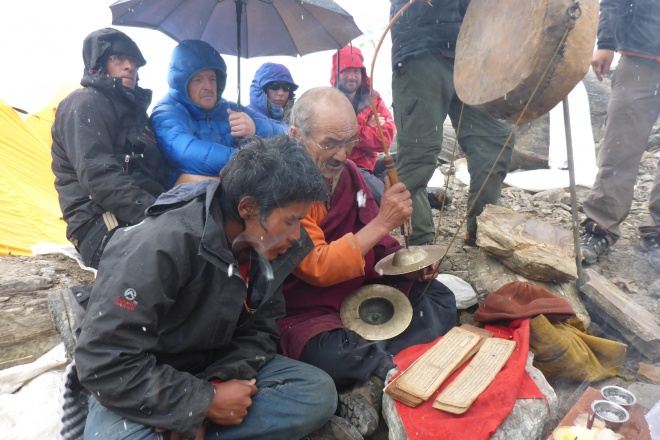

There were 18 teams recorded at the expedition leaders’ meeting at base camp held the day after we got there. These teams ranged from one to seventeen climbers and came from many different nations. A Babel-fest of humanity all with a similar goal: to climb the mountain rising steeply above the glacier. The object that continuously caught the eye and fired the imagination: the mighty Manaslu. Team 360 consisted of 4 experienced climbers. Between them they had climbed Kilimanjaro 16 times, Aconcagua 5 times, Island Peak, Mera Peak, Denali, Elbrus and had run up and down Scotland and the Pyrenees peak-bagging of to do skills courses. Manaslu was their first taste of 8,000 meters but with this level of experience I figured they were ready.

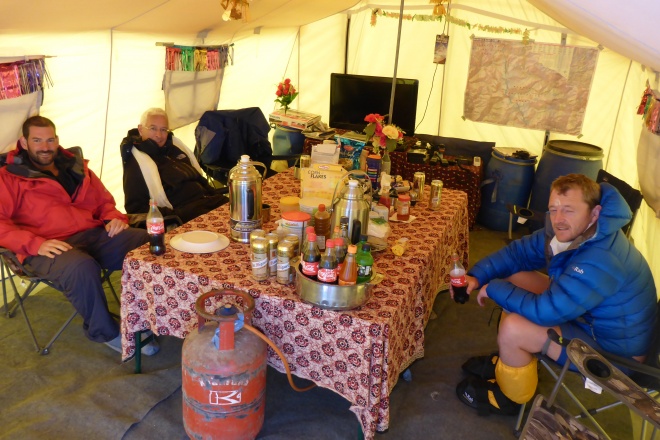
Base camp was like many other base camps I had lived in, dozens of personal tents and colourful stupa’s built amongst a half-kilometre of buckling and crumbling moraine. Our nearest neighbours were a huge creaking and snapping glacier on one side and a noisy serac wall that haphazardly threw small avalanches into our direction on the other. The base camp had the usual dining kitchen, shower and toilet tents but surpassed expectations as the dining tent featuring an enormous TV screen and DVD player. At first my Stone Age instincts balked at the idea but as we settled in and the rain began to fall, and fall and fall, I began to see this as a better alternative to counting the little squares on the tent ceiling as I had done on previous expeditions. The other bonus was our awesome basecamp cook who created masterpiece after masterpiece and seemed to be able to synchronise his cooking with our moods; the rain would get us down and along would come a perfectly grilled chicken sizzler virtually jumping out the pan followed by creamy custard and fresh berries. Often after dinner as the rain and snow bounced off the dining tent ceiling the whole crew, kitchen boys and all, would gather around the table to drink some wine and beer (or the local chang) shoot the breeze and play a card game called “shit head”. At times like this it didn’t seem to matter that the forecast was less than perfect. But we had come here to climb and climb we would!
The general strategy to climb a mountain as enormous as Manaslu is to take it in bite sized chunks and divide the climbing stages between four camps and the summit attempt. Each stage is unique and throws its own challenges at you. To get to camp one you first amble along a moraine wall and then at the aptly named Crampon Point get into glacier mode to traverse the broad back of a heavily crevassed glacier. Camp two is guarded by very noisy and crumbling serac walls and getting through it is the technical and psychological crux of the ascent. The route climbs steep ice gullies and short vertical ice steps and varies with each passing ascent. The route to Camp 3 sneaks under Manaslu’s north peak and zigzags around massive cracks to the top of the ice fall. Camp 4 involves an ever-steepening slog up a vast snow slope beneath a massive hanging glacier and then a mind-numbing traverse to the camp perched safely in a saddle. They told me that the main feature of the summit bid was to cross a big plateau. I couldn’t find the plateau only a steep ridge and sharply inclined snow-slopes intersected by a small shelf the size of a soccer field. The summit itself wouldn’t have been large enough to swing my cat on, if I had brought it.
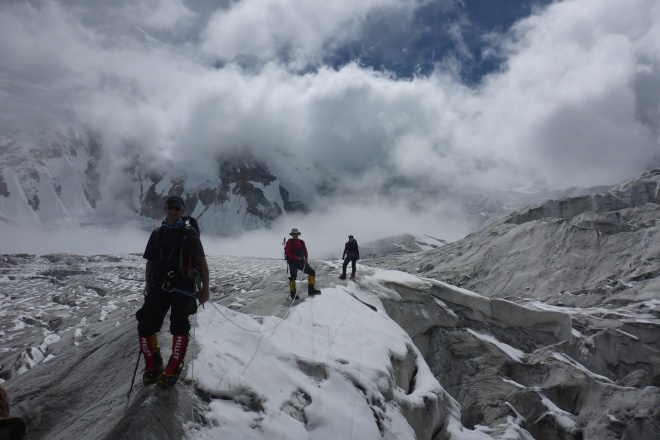
The climbing strategy and the placement of camps differed little between teams as the fixed ropes led on from BC to C4 with only a few gaps. This rope had been fixed primarily due to the hard work of the Sherpa from the largest expedition on Manaslu this year; a task they had specifically come to do. We donated nearly 900 meters of rope and dozens of snow-stakes and ice-screws to aid them and our Sherpa team aided in the “fixing” of C3 to C4. If you had come to basecamp with the intention of just using the rope fixed by this team than you were asked to pay them a couple of hundred dollars, which is fair enough. But ladders were squashed by truck-sized ice blocks and ropes buried or wiped out by snowfall and avalanche because of the mountain’s continuous mood swings. The rope-fixing team had a busy time of it.
The climbing strategy and camp locations might have been similar amongst all the teams but the climbing style varied enormously. Leaders of the pack were two Slovaks who went at it like true defenders of the faith: unsupported, no oxygen, carrying all their own loads, cooking their own meals, chipping ice for water, pitching their own tents and making their own decisions regarding weather and climbing days. In fact our own 360 team too a similar approach, apart from the fact that we used a sat-phone to get the weather forecast rather than put our fingers in the air to feel wind movement or look at clouds to see what the future would hold, we had a few good Sherpa friends plus we used oxygen after we zipped our tents shut at C4 and headed for the top. Other climbers chose to take an easier, less strenuous approach: helicopters to and from Samagoan (near basecamp), oxygen from 6,700 meters, Sherpa carrying everything and fluffing pillows. It’s not a style of climbing I would personally find rewarding but who am I to start this whole argument about murdering the impossible all over again.
Mike called it quits at camp one. In total we had clocked up 3 nights at this camp in order to get acclimatised. The noisy icefall and the risks involved in climbing through it had given him the creeps. “I’m going to have to call it quits man, I’m afraid there will not be a hundred percent on this one” were his parting words. Less than an hour later Peter also signalled to go down. The icefall and a tough week of humping loads to camp one and finding them buried under a foot of snow had taken its toll. “Peter is also going down, he’s ok” came over the radio from Ang Phulba. This left only Jo, Arthur and me gunning for camp two. The icefall certainly had a sense of playing Russian roulette in places but we passed through quickly. The most exciting bit was actually over too fast. After a night at camp two we climbed up to 6,400m, just short of camp three and then headed back down to base camp to rest up for a summit bid. I figured on two days rest and then going to camp four via a night at camps one, two and three.
The forecast sent from the office was that the day of the 25th of September was going to be cold but clear with little wind. However, that evening a developing storm was promised. The beginning of the end for the season; continuous snow storms and the onset of high altitude wind till early October. It was going to be just one day off before the summit bid, we had to take our chances.
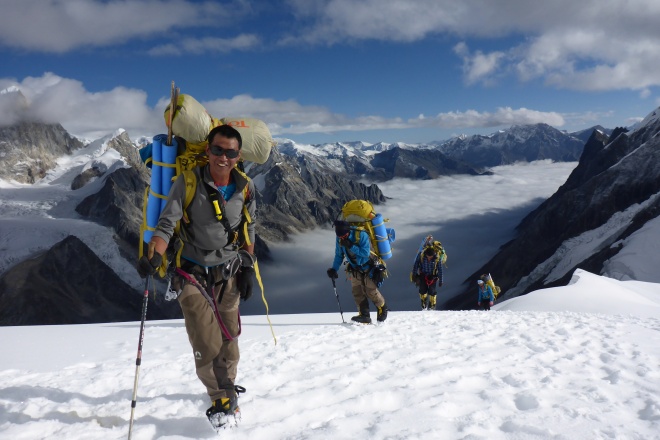
Summit day starts many days before. You hump loads between camps and spend nights there, acclimatising to increasingly higher altitudes than dropping down for a rest before the summit bid. It is a tried and trusted principle of climbing big mountains that is usually combined with crossed fingers for a favourable weather spell. For the 360 team the forecast was met with only positive reaction. The main reason was that if the weather turned out as good as predicted than it was going to be safe going and an easy ascent to prepare for. The second was that we had run out of cool DVD’s and that our first night back at base camp had brought about intense cabin fever. We were glad to be moving up again albeit a little sooner than expected.
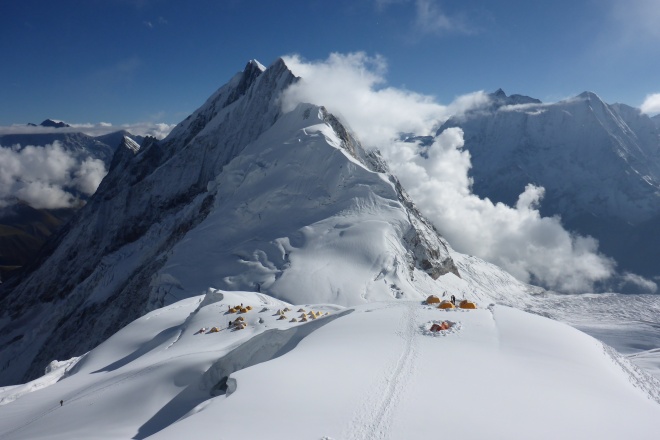

We all reached camp four beat up. Jo and I came in last after seven hours on the hoof. Arthur and the three Sherpa had been busy and the tents were up. Water was on the boil. Jo and I stripped off our boots and squashed in with Arthur. Ang Phulba asked for my sat-phone to do a last minute Puja via his wife waiting in a monastery in Kathmandu. It was all go. I hadn’t been optimistic about getting much sleep but was surprised at how much I did get to conk out. Than a violent urge to hawk up a lot of weird stuff woke me up early and with it a reminder from someone to get into my down suit, and check the sky. I switched my oxygen cylinder to a flow-rate of 2 litres an hour. We were going to the top.
The climb to the 8th highest point on planet earth was just as forecast. We woke up early and were on the move, suited and booted by 1:30 am. Getting used to the oxygen system didn’t take long but I became quickly out of breath from the pace set by phulba and Arthur. I signalled for them to stop and wait so Jo and I could get our stuff together and for the fixing team to shoot ahead and fix a section of steep ridge looming ahead. Within minutes dozens of climbers had passed us and we became involved in a game of following the light ahead of you and listening to yourself breathing.
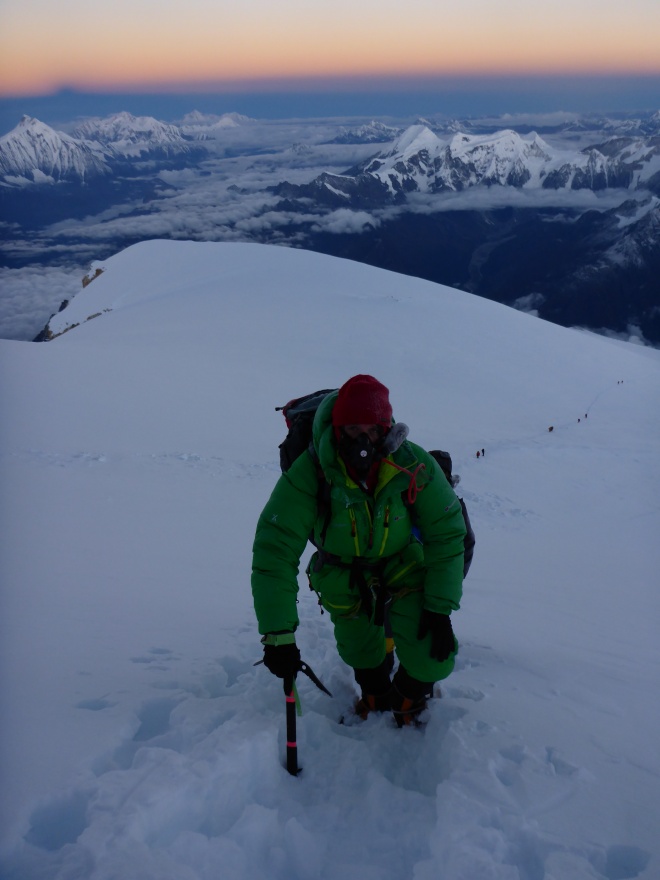


We stopped just short of the summit and joined an orderly queue. The climbing to this point had been interesting. Not a plateau to be seen and a lot of steep stuff covered, ascended mostly without fixed rope. I‘d reset my flow-rate to 3 litres a minute at 8,000 meters and had felt strong; a queue was the last thing I had expected. It took the team ahead a while to unfurl banners and wave at the cameras. The summit is about as big as a coffee table and accommodates one wheezing mildly panicked dude at a time. We bided our time and took in the spectacle; one guy fell of the ridge to be caught by the fixed line and another snagged his crampons, stumbling hard into his team.
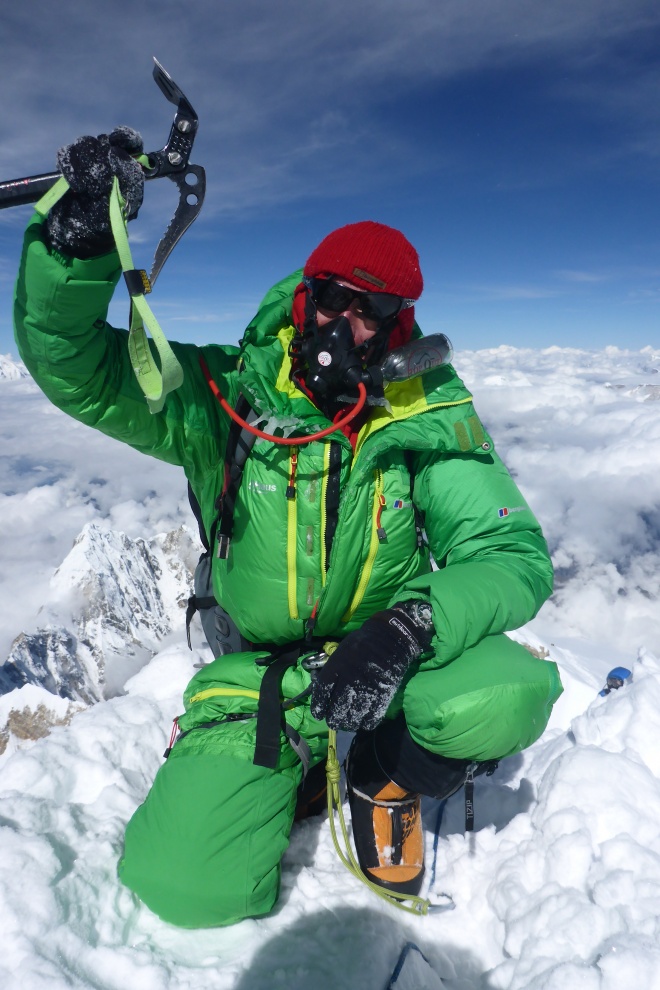
Then it was our turn to move our way along the ridge to the top. I went first followed by Arthur and Jo. I managed to make a call home and became choked up when I spoke to Marni. Not the first time on a summit but certainly rare. I posed for the camera as Ang Phulba shot about 20 photos in as many seconds. The mountain had been climbed. I was joined on top of this majestic place by the remnants of the 360 team. We soaked up the views, felt the frigid air and stored memories that will last with us to the grave. And after a few minutes we looked back down the ridge we had climbed and took the first step home.

You can checkout a great video shot by the team climbing along side us here.